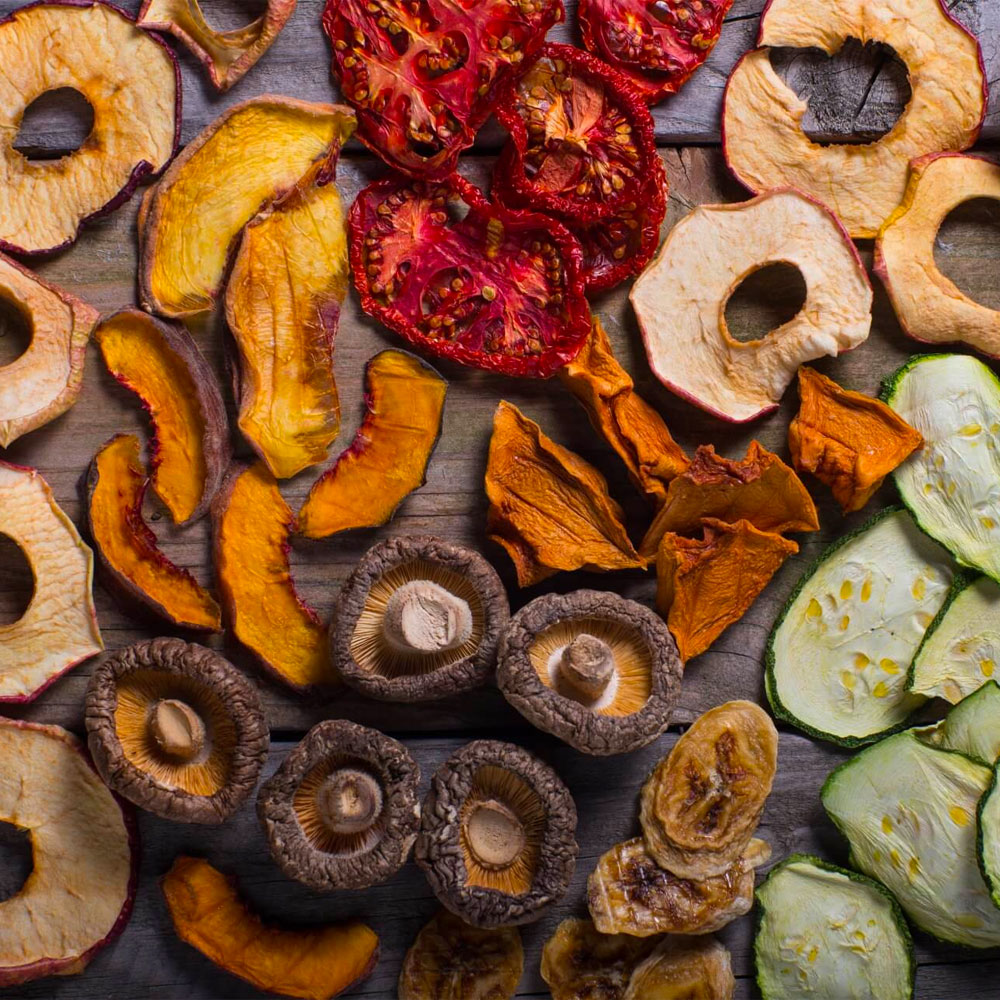Introduction to Drying Techniques
Dried vs dehydrated fruit! Drying fruit is a time-tested method to preserve its goodness. People have been reducing the water content in fruits, extending their shelf life, and making them convenient snacks for centuries. Today, with advanced technology, two popular techniques stand out: dehydrating and freeze-drying.

Dehydrating fruit involves using heat to remove moisture. This method has been used since ancient times. It creates a chewier, concentrated fruit snack. Tools for dehydration range from the sun’s natural heat to modern dehydrators that can sit on your kitchen counter.
In contrast, freeze-drying is a more recent innovation. This method freezes fruit first and then removes the water through a vacuum process. It keeps fruits crisp and retains their original shape. Although it requires more specialized equipment, the results are impressive.
Each technique has strengths. Dehydrated fruit is soft and chewy, while freeze-dried fruit is light and crispy. The choice between dried and dehydrated fruit affects shelf life, nutrition, taste, and how you can use them in recipes. As we dive deeper into the drying world, the nuances of each process will reveal which fruit form may be the best fit for your pantry and palate.
The Dehydrating Process
Dehydrating fruit is a basic yet effective way to extend the life of perishable goods. Through the application of heat, either naturally from the sun or artificially using an oven or a commercial dehydrator, the moisture is removed from the fruit over several hours. Typically, temperatures range from 140 to 170 degrees Fahrenheit (60 to 76 degrees Celsius), but it’s vital to not exceed these temperatures as it might cook the fruit instead of drying it slowly. As the heat draws water out, it also intensifies the fruit’s natural flavors, resulting in a chewier texture and a sweetness that’s more concentrated than in fresh fruit.
Advantages:
- Less Equipment Needed: Dehydrating fruit doesn’t require specialized equipment. A simple oven or a basic home dehydrator will do the job.
- Energy Efficient: Dehydrating can be energy efficient, especially if you’re utilizing natural heat like that of the sun.
- Longer Shelf Life: While not as long as freeze-dried fruits, dehydrated fruits can last several months or more when stored properly.
- Convenience: Dehydrated fruits are easy to store and carry, making them a good option for snacks on the go.
Process Steps:
- Prepare the fruit by cleaning and cutting it into thin, even slices.
- Arrange the slices on dehydrator trays or baking sheets if using an oven.
- Heat at the recommended temperature for the required duration, checking for the desired chewy texture.
- Once dried, store the fruit in a cool, dark area, ideally in an airtight container to keep out moisture and prolong shelf life.
Remember, preserving fruit through dehydration does remove some of its nutritional value, especially heat-sensitive vitamins like Vitamin C. But, dehydrated fruits still offer dietary fiber and a natural sugar boost. Various fruits from apples to bananas can be easily dehydrated at home, and they retain a good portion of their taste and nutrients, albeit in a denser, chewier form.

The Freeze-Drying Process
Freeze-drying fruit starts by freezing it first, then removing its water using a vacuum. This method keeps the fruit’s texture crispy and retains its original shape. Unlike dehydrating, freeze-drying is done at low temperatures using advanced equipment.
Advantages:
- Preserves Texture and Shape: The freeze-drying process keeps fruits crispy and maintains their original form.
- High Nutrient Retention: This method preserves most of the fruit’s nutrients, making it a healthier option.
- Extended Shelf Life: Freeze-dried fruits can be stored for many years without spoiling.
- No Additives Needed: The process doesn’t require preservatives to keep the fruit fresh over time.
Process Steps:
- Start by freezing the fresh, prepared slices of fruit quickly to capture their peak flavor and nutrients.
- After freezing, the fruit goes into a vacuum chamber where low heat is applied very subtly.
- The ice within the fruit sublimates; it turns directly from solid to gas, bypassing the liquid phase.
- Once dried, the fruit is removed and sealed in moisture-proof packaging to ensure freshness.
The crispness and flavor of freeze-dried fruits make them excellent for direct snacking or use in various dry applications, like cereal mixes and baking. Despite the higher costs associated with the freeze-drying process, the extended shelf life and quality justify the investment for many consumers.
Shelf Life: Dried vs Dehydrated Fruit
When it comes to preserving fruit, shelf life is a key factor. Let’s compare dried and dehydrated fruit in this regard.
Dried, or freeze-dried, fruits have a notable advantage. They boast a shelf life that can span years without losing quality. This is thanks to their low moisture content. Properly packaged, they resist spoilage and retain their flavor and crispiness.
Dehydrated fruits, while still long-lasting, don’t measure up in longevity to their dried counterparts. They hold about a third of their water content. Because of this, they can succumb to bacteria and molds faster. In ideal storage conditions, dehydrated fruits may last several months to a year.
Both benefit from cool, dark storage to stay fresh longer. A clear container is not ideal, as it lets in light. The container should be airtight too. This keeps out moisture and other contaminants.
Overall, if you want fruit that stays fresh for an extended period, dried fruits come out on top. They last longer and maintain their taste and crunch. For a shorter term and budget-friendly option, fermented fruits do the job well.

Nutritional Comparison: Preserving Your Health
When considering the nutritional impact of dried vs dehydrated fruit, there are significant differences to note. Freeze-drying, for instance, is exceptional at preserving nutrients. It retains almost all of the original nutritional content of the fruit. This is because the process avoids high temperatures that can break down vitamins and enzymes.
Nutrient Retention in Freeze-Dried Fruit
Freeze-dried fruit keeps up to 97% of its nutrients. This process involves only the removal of water, keeping the structure and nutrients intact. Hence, it offers almost the same value as fresh fruit.
Nutrient Loss in Dehydrated Fruit
On the other hand, dehydrated fruit generally loses more nutrients, including vital vitamins like A and C. This loss results from the heat used in the drying process. Dehydrating can reduce nutritional content by up to 40%. Despite this, dehydrated fruits still provide fiber and natural sugars.
Both methods significantly reduce the fruit’s water content, which is beneficial for long-term storage but impacts the fruit’s nutritional values differently. Therefore, if nutrition retention is your goal, freeze-drying might be the better choice.
Taste and Flavor Profile
When picking between dried and dehydrated fruit, taste is key. Let’s explore how freeze-drying and dehydrating change a fruit’s flavor.
Freeze-Dried Fruit Flavor
Freeze-drying keeps flavors almost like fresh. The process uses low heat, so taste and smell stay true to the fresh fruit. With freeze-dried fruit, you get a burst of natural flavor in a light, crispy form.
Dehydrated Fruit Flavor
Dehydrating changes a fruit’s taste. It often makes the flavor more intense but can also cause some loss, especially with heat-sensitive notes. Dehydrated fruits are chewier, and their sweetness gets concentrated. They are a hit for a richer, denser snack.
The texture of both dried and dehydrated fruit also impacts the eating experience. Crunchy freeze-dried fruits are fun and light, while chewy dehydrated fruits give a satisfying bite. Your choice will depend on what flavor and texture you prefer or what a recipe calls for.
In summary, dried fruits excel in retaining the original taste, offering a crisp texture and fresher flavor. Dehydrated fruits, although chewier, present a sweeter and more intense version of the original fruit’s taste. Both can be great options; it’s all about your taste preference and how you plan to use them.
Practicality and Use in Recipes
When incorporating dried fruits into recipes, assess their practicality based on two factors: texture and moisture.
Texture Adaptability
Freeze-dried fruits, with their light and crisp qualities, don’t give out moisture. They’re ideal for adding to dry mixes, like granola, or for garnishing desserts without causing sogginess. Their crunchy texture also adds a delightful contrast in creamy dishes such as yogurt or ice cream.
Dehydrated fruits, being chewy, blend well in baked goods like cookies or muffins, where they can provide a moist and dense texture. They’re also suitable for longer-cooking dishes, like stews, where they can absorb liquid and rehydrate, infusing the dish with their concentrated flavor.
Moisture Consideration
When using dried fruits in recipes, remember that freeze-dried fruits will absorb liquid and can become rehydrated. This makes them versatile for both dry applications and dishes where they can soak up flavors. On the other hand, dehydrated fruits already carry inherent moisture, so they won’t drastically change in texture but can add natural sweetness and a chewy component to various dishes.
In conclusion, both dried and dehydrated fruits offer unique characteristics that cater to different culinary needs. Freeze-dried fruits excel in applications where crispness is desired, while dehydrated fruits are ideal for adding chewy texture and rich flavors to a variety of recipes.
Cost Considerations for Consumers
When choosing between dried vs dehydrated fruit, cost plays a big role. Freeze-drying involves more complex machinery and processes compared to dehydrating. This makes freeze-dried fruit generally more expensive. Here are a few points to consider regarding the cost implications of each method:
- Initial Investment: Freeze drying requires a significant initial investment in equipment. Dehydrating can be done with simple ovens or affordable dehydrators.
- Operating Costs: The energy consumption for freeze-drying is higher due to the sublimation process. Dehydrating uses less energy as it involves lower temperatures.
- Longevity and Waste: Though more costly upfront, freeze-dried fruit may provide value over time. Its longer shelf life means less waste, potentially offsetting the initial higher costs.
- Price per Batch: Due to the longer process and technology used, freeze-drying can have a higher cost per batch of processed fruit.
- Market Prices: Freeze-dried fruits typically command higher retail prices. This reflects their extended shelf life and better nutrient retention.
- Bulk Buying: Buying in bulk could reduce costs for either method. Suppliers often offer discounts for larger purchases.
In essence, weighing the long-term benefits against the initial cost will help consumers make a financially sound choice between dried vs dehydrated fruit.


